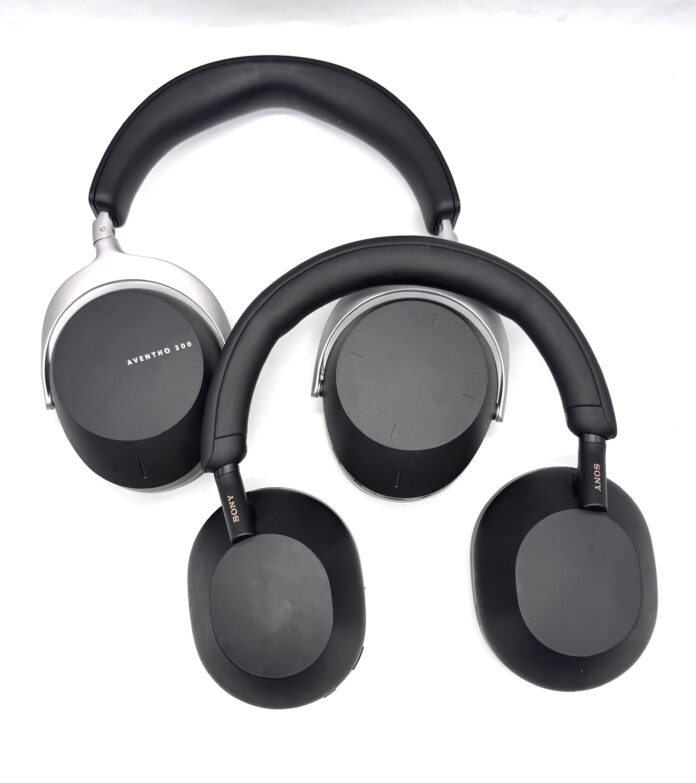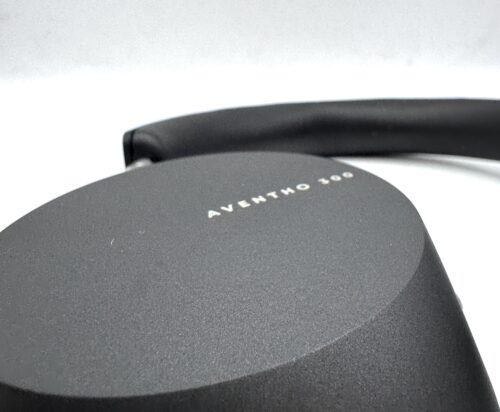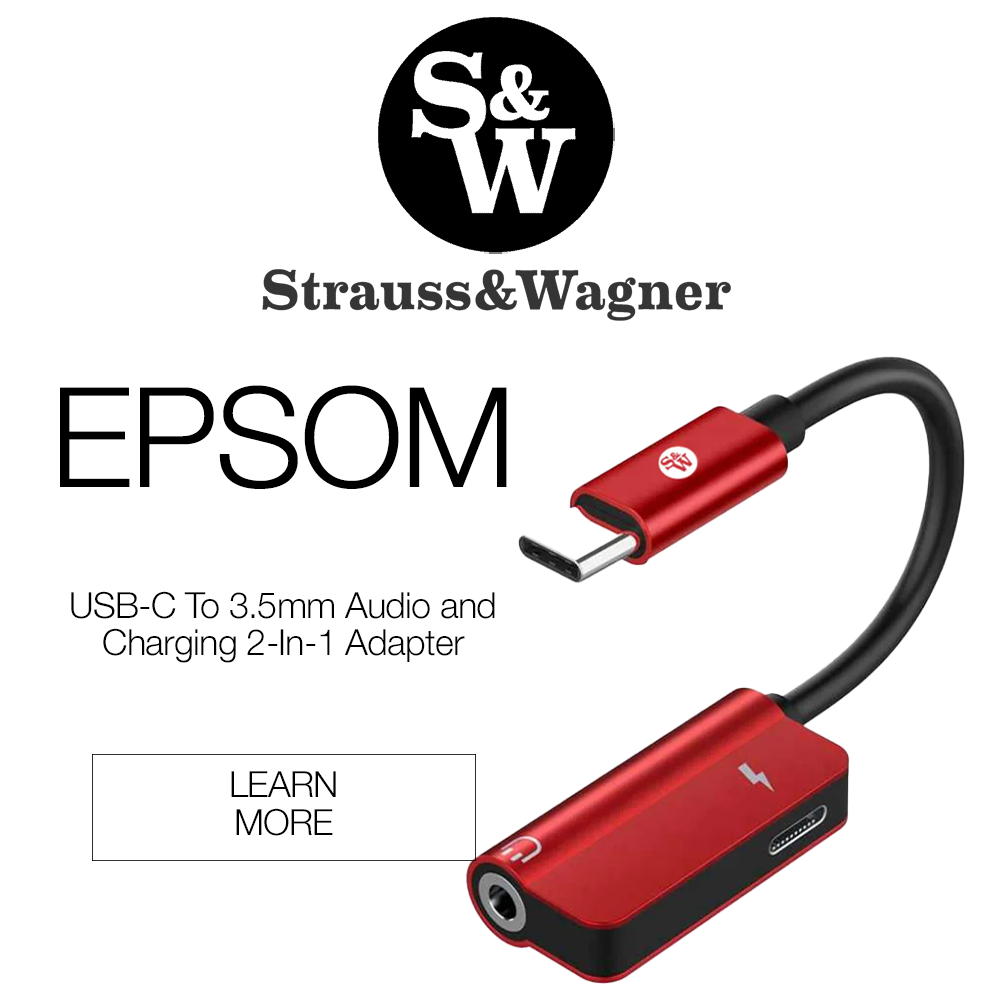If you read our review on the Beyerdynamic AVENTHO 300, you know we loved it. We loved it so much, in fact, that it made our list of top wireless headphones of 2024. With all of our praise for it, we wondered how it would stack up against some other heavyweights in the wireless headphone space. So today we’re putting it up against the Sony WH-1000XM5 to see how the two headphones stack up. The AVENTHO 300 ($399) and WH-1000XM5 ($398) are both excellent options available under $400. But which one is the best wireless headphone? We’ll compare build, functionality, sound quality and much more in this review.
Unboxing the Beyerdynamic AVENTHO 300 and Sony WH-1000XM5:
| Beyerdynamic AVENTHO 300 | Sony WH-1000XM5 |
|
|
Build:
With the AVENTHO 300, Beyerdynamic created a stylish and premium feeling headphone. Though it doesn’t stray too far from common design aesthetics, it does use high quality materials that contrast colors, and simultaneously feels luxurious and comfortable. To achieve this feel, the Bluetooth headphones use aluminum in its swivel joints, memory foam for its ear pads and headband, and durable plastic for the ear cups and other features. Also of note is the shape of the headphones, which has its own unique look that distinguishes it from other headphones. With these materials, the headphone reaches great levels of comfort, with its ear pads providing a great seal and a soft and cozy fit.
With the XM5, Sony also looked to pivot into more unique design aesthetics. While the XM3 and XM4 had similar appearances, the XM5 overhauled the look of the 1000X line. While the XM5 uses more plastic in its build than the AVENTHO 300, that plastic is actually made from recycled materials from auto parts. Sony’s support for environmentally conscious design makes for a lightweight headphone that is impressively flexible and built to last. And if the AVENTHO 300 is more rigid in its solid frame, the XM5 is more limber. Ultimately, they both feel quite durable through their own engineering methods.
The one note I’d add is that neither headphone folds, making them a little bit harder to pack and transport. Still, with the AVENTHO 300 coming in at 319 grams and the XM5 at 250, they’re both exceptionally lightweight. While Sony takes the cake in sheer lightness, they are both some of the more comfortable wireless headphones available.
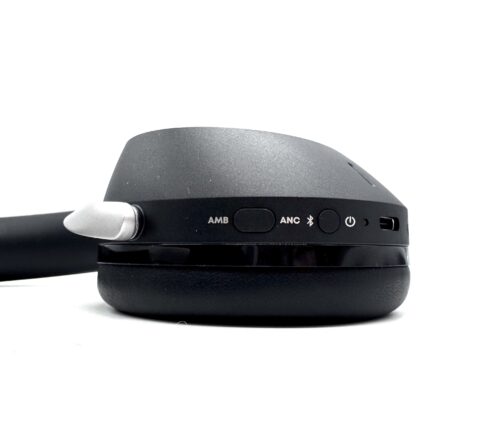
Design:
To drive its sound, the AVENTHO 300 utilizes Beyerdynamic’s in-house STELLAR.45 driver unit. It’s a great driver unit that the company features in many of its studio headphones. STELLAR.45 is a dynamic driver and is implemented at an angle to improve soundstage and imaging. It also includes active noise cancelling, whose strength can be adjusted in the app from levels 1-5. The noise reduction quality is quite good, but maybe not quite as good as Sony’s industry leading tech. However, the noise cancelling doesn’t interfere very much with sound quality, and is overall pretty good.
Like I said, the XM5 is an industry leader when it comes to its sheer strength of noise reduction. The XM5 and AVENTHO 300 share features like transparency modes, touch sensor controls on their ear cups, and companion apps (Sony Sound Connect was overhauled last year). Both also offer Dolby Atmos spatial audio experiences, though the AVENTHO 300 might have the edge here (but it’s close).
Sony uses a 30mm driver unit with a soft thermoplastic polyurethane edge that is meant to enhance ANC. That 30mm driver features a carbon fiber dome that looks to improve sound quality, especially in the upper registers. Overall these headphones are pretty competitive on design elements, and a winner may only be discernible based on user preferences.
Bluetooth:
Given the AVENTHO 300 came out in 2024, two years after the XM5, it’s natural that Beyerdynamic’s wireless headphones support some more advanced Bluetooth capabilities. Using Bluetooth 5.4, the AVENTHO 300 can play aptX Lossless (as well as lower quality codecs, which you can control in the companion app). It, like the XM5, has multipoint, allowing you to connect to two devices at once. That said, multi-point is much easier to enable on the XM5. Sony’s Bluetooth support is limited to version 5.2, limiting its highest codec to LDAC, which is still quite good. You can control codecs in the Sony Sound Connect app. As far as connection goes, both work great without any dropouts or issues. If you prioritize lossless Bluetooth transmission, then the AVENTHO may be your best bet. However, if ease of use is more important, then Sony may offer a better solution here.
Battery:
Battery life is cut and dry. The AVENTHO 300 gives you up to 50 hours of playtime while the XM5 rounds off at about 30 hours. Both work with wired connections but that functionality prohibits the use of ANC. Both offer lots of playback time, but ultimately, the AVENTHO 300 wins here.
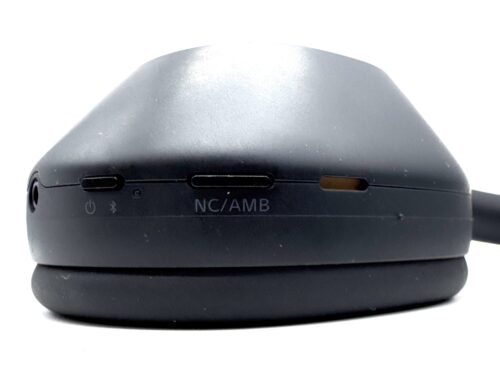
Sound Impressions:
Low End:
The AVENTHO 300 and XM5 go for two very different approaches when it comes to bass. Beyerdynamic’s wireless headphones are more neutral with a somewhat cool sheen to it that feels a bit more “audiophile” in nature. Don’t get me wrong, there’s plenty of slam and punch and a good sense of detail when the music calls for it, but it doesn’t reach the magnitude of Sony’s. But while the XM5 has a higher quantity of bass, it’s a bit less refined with some midbass bloat and less definition than the AVENTHO 300. This will ultimately come down to your taste. If you like a warm and fun bass that chooses listenability over complete precision, then the XM5 has that. It’s engaging and energetic and there’s nothing wrong with that. However, if you want a more neutral listening experience with more of a focus on detail than overall musicality, then the AVENTHO 300 might be better for you.
Midrange:
As far as midrange goes, both of these headphones are somewhat V-shaped. The XM5, with its rich midbass, feels a bit warmer than the AVENTHO 300, though the Beyerdynamic headphone is once again more detailed with a greater sense of space. Where they differ is in terms of space. The XM5 feels a bit more intimate with more attention to dynamics and texture. The AVENTHO 300 leans more towards that cool sound, with music taking a more distant quality. This contrasts nicely with its more forward bass response, giving room for its low end frequencies to develop and complement that midrange information. So this will come down to Sony’s more warm and intimate sound vs. Beyerdynamic’s more spacious but distant sound experience.
Top End:
Both the AVENTHO 300 and XM5 shine in the top end. Beyerdynamic has a reputation for bright treble, but they keep things under control with the AVENTHO 300. Meanwhile, the XM3 and XM4 were somewhat lacking in treble, and the XM5’s better tuned top end was one of our favorite improvements on that headphone. Both Beyerdynamic and Sony have implemented high quality top ends to these headphones. They each have great headroom and excellent detail, and so I’ll call this one a tossup.
Soundstage:
Beyerdynamic and Sony both incorporated spatial audio into their headphones. As such, they both have an awe-striking sense of presentation when used with compatible tracks. Still, the XM5 feels a bit more intimate than the AVENTHO 300. But where the XM5 feels a bit more direct, the AVENTHO 300 appears a bit more elusive. There’s almost a sensation that the music AVENTHO 300’s is floating around you rather than just sitting in stasis. I personally prefer that wider sound, though some might prefer the more forward and natural presentation of the XM5. Ultimately both soundstage presentations play into their overall tuning and feel appropriate for the sound quality they’re each trying to achieve.
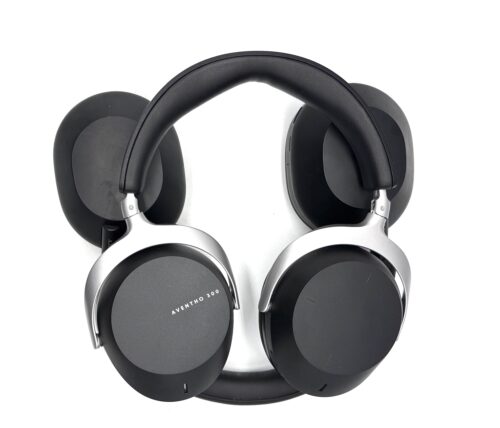
Final Thoughts:
Beyerdynamic and Sony have both produced great wireless headphones in the AVENTHO 300 and WH-1000XM5. In comparing the two, I found the AVENTHO 300 to cater more to audiophile needs, with a cleaner sound, aptX Lossless, and a more sophisticated build. On the other hand, the XM5 is lighter, has better noise reduction, and is much-more user friendly (not to mention its more fun bass response). Both are available as great options in the mid-fi wireless headphone bracket, and the choice will ultimately come down to your preferred user experience. But hopefully this breakdown helps in your decision between the two.
The Beyerdynamic AVENTHO 300 and Sony WH-1000XM5 are available at Audio46.
MAJORHIFI may receive commissions from retail offers.


